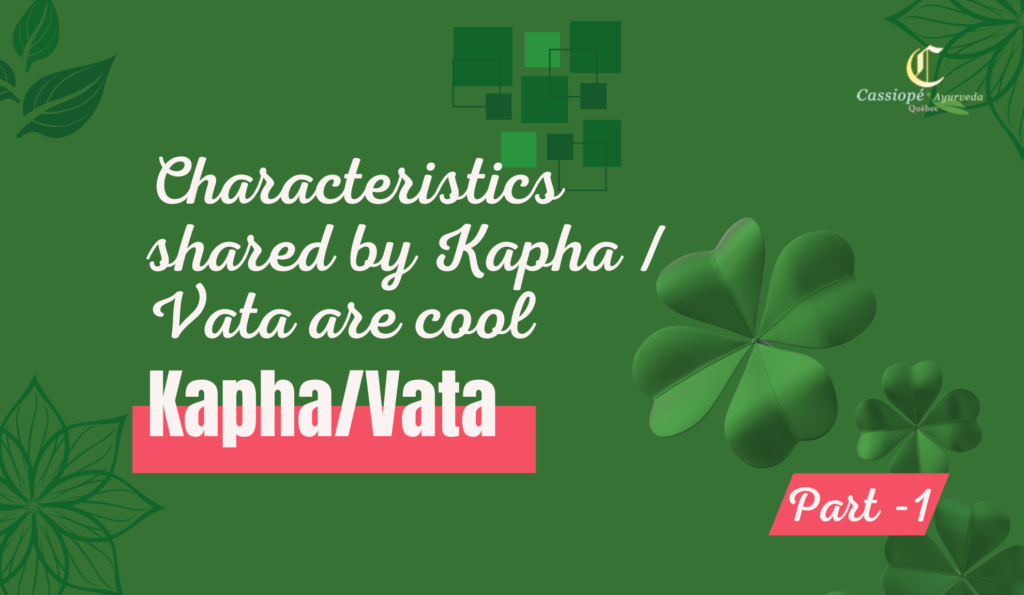While Ayurveda provides valuable and detailed guidance for daily practices, foods, meditation and movement methods, self-care techniques, and seasonal living for each specific dosha, it can be difficult to know which lifestyle guidelines to follow if you have a dual Prakriti or a combination dosha.
Having a dual Prakriti means that your mind-body type is dominated by two doshas (or three for the rare ‘tri-doshic’ types) rather than one.
Many people are primarily Vata, Pitta, or Kapha, but if you take a dosha test and find that your scores for two dosha types are equal or very close, you are most likely a combination of the two.
Understanding the Characteristics
To achieve balance with combination doshas, we can examine the characteristics of each dosha and then recognize the characteristics that the two doshas share.
For example, Kapha and Vata both have coolness and coldness, while Kapha and Pitta both have moisture and oiliness. The only dosha that is dominated by heat is Pitta, and the only dosha that is prone to excessive dryness is Vata.
When we understand the characteristics that the doshas share, we can work on balancing them with the opposite qualities. The opposite brings balance. Examine the characteristics shared by the combination doshas:
Characteristics shared by Kapha / Vata are cool, cold
Kapha / Vata is a dosha present in every human being. It is responsible for promoting growth and development and bringing stability to the body and mind.
Kapha / Vata is also associated with mucus, which lubricates the body’s surfaces.
Prone to low mood levels and anxiety
Kapha and Vata are two different elements that can be found in your body. Kapha is the earth element, and Vata is the air element. The earth element builds your physical body structure, while the air helps it move.
The characteristics of these two elements can often show up as low mood levels or anxiety.
If you’re prone to feeling anxious, depressed, or having trouble sleeping because you’re worried about things happening in your life, your body may need more balance between these two elements.
fatigue
Fatigue is a common characteristic shared by both Kapha and Vata types. Both doshas have an increased tendency to experience fatigue due to their inability to digest food properly. Poor digestion may indicate that your body is too cold or too dry (i.e., whether you are hungry or full).
Suppose you feel tired after eating a meal, such as experiencing lethargy after lunchtime or groggy after dinner. Such symptoms may include bloating, constipation or loose stools, burping, and gas.
In that case, this could be due to improper digestion, where the body cannot break down nutrients effectively into smaller bits that can be absorbed into your bloodstream.
Tendency to procrastinate
It is common for people with a Kapha or Vata constitution to be late in finishing their work. These individuals often feel like they need more time to complete their tasks, and when this happens, they may try to put off working on the project until later.
The tendency toward procrastination is due largely to the cool and dry nature of these doshas; it’s much easier for them than us hot-blooded Vata types (who are sometimes too quick on our feet) or Pitta people (who can get burned if we’re not careful).
However much we might want an excuse not to do something unpleasant—like making a phone call—the truth is that it will only get harder once you’ve started putting things off rather than doing them immediately.
low self-esteem

Kapha/Vata is likely to feel inferior, inadequate, and like a failure. They tend to have low self-esteem and low self-confidence.
This is not just about feeling bad about oneself but about the tendency to doubt oneself. In contrast, Pitta individuals tend to be confident in their abilities, while Vata people may lack confidence in themselves or others they admire or depend on.
Self-care tips for this individual
Self-care tips include drinking warm lemon water in the morning, adding warming spices to foods (such as ginger, cinnamon, black pepper, and cayenne pepper), and self-massaging with warm oil.
Skincare tips for combination doshas
Skincare for Kapha/Vata
Of course, using a combination of products will help you take the best possible care of your combination dosha skin. I advise using the Purifying range for Kapha/Vata types in the spring and the Radiance range in the fall. While paying attention to the season and how you feel on any given day.
Use the Radiance toner, exfoliate with the Purifying line, and combine the Purifying day cream and Radiance facial oil for the remainder of the year.
When choosing a night cream, consider whether your skin is heavy, oily, or dry and needs tender loving care. Use the Radiance night cream if your skin feels dry at night and the Purifying night cream to balance congestion and oiliness. Body oil should be warmed before use.
Conclusion
Many people are primarily Vata, Pitta, or Kapha, but if you take a dosha test and find that your scores for two dosha types are equal or very close, you are most likely a combination of the two.
When this is the case, paying attention to both doshas is essential. If you have a combination dosha, it’s best to work on the way to keep them balanced rather than trying to focus on one dosha. This can be done with diet, exercise, and lifestyle changes.





